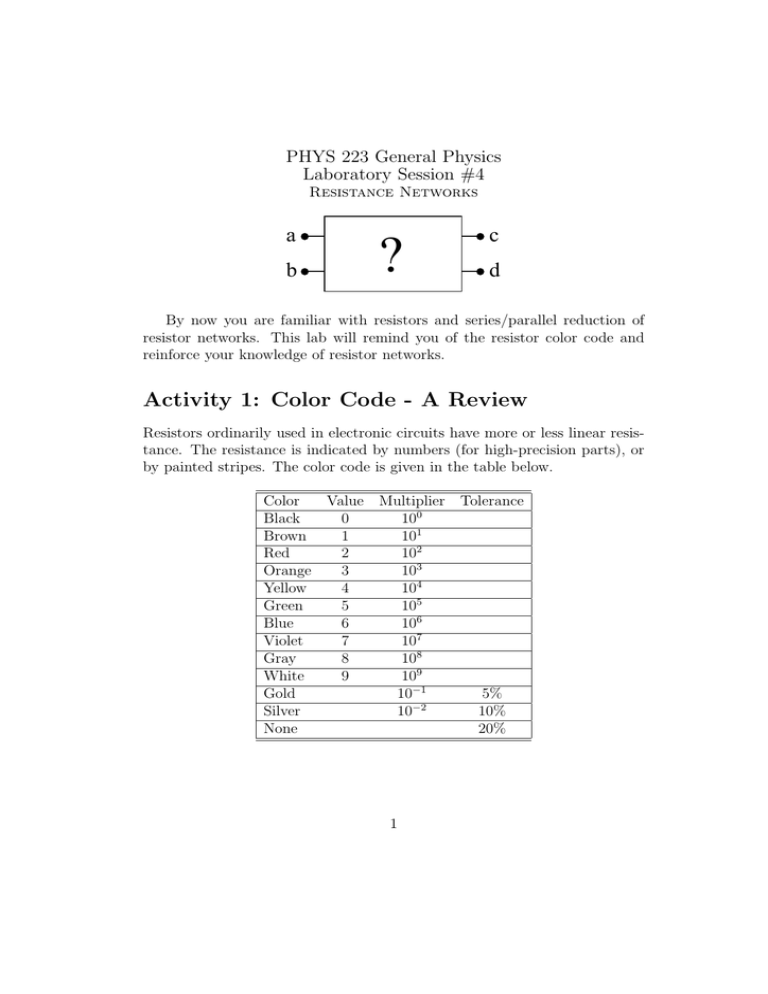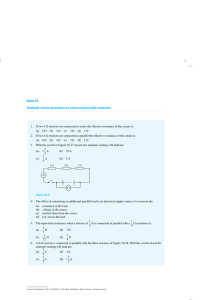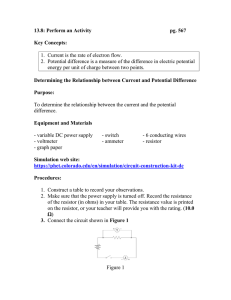a b c d Activity 1: Color Code - A Review
advertisement

PHYS 223 General Physics Laboratory Session #4 Resistance Networks a b ? c d By now you are familiar with resistors and series/parallel reduction of resistor networks. This lab will remind you of the resistor color code and reinforce your knowledge of resistor networks. Activity 1: Color Code - A Review Resistors ordinarily used in electronic circuits have more or less linear resistance. The resistance is indicated by numbers (for high-precision parts), or by painted stripes. The color code is given in the table below. Color Value Multiplier Black 0 100 Brown 1 101 Red 2 102 Orange 3 103 Yellow 4 104 Green 5 105 Blue 6 106 Violet 7 107 Gray 8 108 White 9 109 Gold 10−1 Silver 10−2 None 1 Tolerance 5% 10% 20% Tolerance Read from this end Example: Yellow−violet−orange−silver 3 47 x 10 5% 47,000 ohms +− 5% 47K +− 5% First digit Multiplier Second digit Individual Resistors You are given five resistors R1 . . . R5 . Record the color code on each resistor and “decode” the values. Identify each resistor with a bit of masking tape. Using a digital ohmmeter, measure the resistance of each resistor and record this, as well. A table is convenient: Resistor number 1 2 3 Color Code Value Ohmmeter Value ETC. Equivalent Resistance Examine the resistor networks below. In each case, predict what the equivalent resistance of the network will be. Then, using the circuit board provided and perhaps some alligator clip leads, construct the networks and measure the equivalent resistance of each circuit. (Again, use the digital ohmmeter.) Make sure that you have good connections between resistors and that you press the ohmmeter leads tightly against the resistor wires when measuring resistance. 2 Circuit 3 Circuit 1 R1 R2 R3 R1 R5 R3 R4 Circuit 2 R1 Circuit 4 R1 R3 R3 R4 R4 R5 R2 Activity 2: Black Boxes Several “black boxes” are available in the lab. (Some may be different in color.) They contain simple resistor networks connected to the four terminals. Your job is to deduce the network contained in two of the black boxes. Identify each box you work on by its number. Measure the resistance between every pair of terminals (a-b, a-c, etc.). You will have six resistance measurements for each box, then. From this information, draw the simplest resistor network which could possibly be in the black box. a b ? c d Each group should analyze 1 different resistor boxes for each person in the group (minimum of 3 boxes). 3 Activity 3: Resistance networks and voltage drops I. Set up the circuit below with 3 resistors of equal value. The power source should be a power supply operating at 5 V. Using a digital voltmeter, measure the voltage drop across the power supply. Now, before doing the measurement, predict what the voltage drops will be across each resistor. You should not have to calculate any currents to do this! Do the measurements with a voltmeter and compare to your predictions. R1 R2 + V − R3 R1 = R2 = R3 II. Now set up this circuit, with 4 resistors of equal value. Predict the voltage drop across each resistor. Measure the voltage drops and compare with your prediction. R1 + V − R2 R3 R4 R1 = R2 = R3 = R4 4 Activity 4: Resistor Cube Get a resistor cube from your instructor. Do the following: 1. Use the resistor color code to determine the resistance of a each resistor in the resistor cube. 2. Assuming the value you determined is correct for each resistor, use symmetry to determine the resistance of the cube from one corner to the opposite corner. 3. Measure the resistance of the cube. 4. Compare and Contrast. Is your measurement within tolerance? 5. Assuming the value you determined is correct for each resistor, use symmetry to determine the resistance of the cube from one corner to an adjacent corner. 6. Measure the resistance of the cube. 7. Compare and Contrast. Is your measurement within tolerance? 5 Activity 5: Conceptual Questions Serway, 1-15. 6







